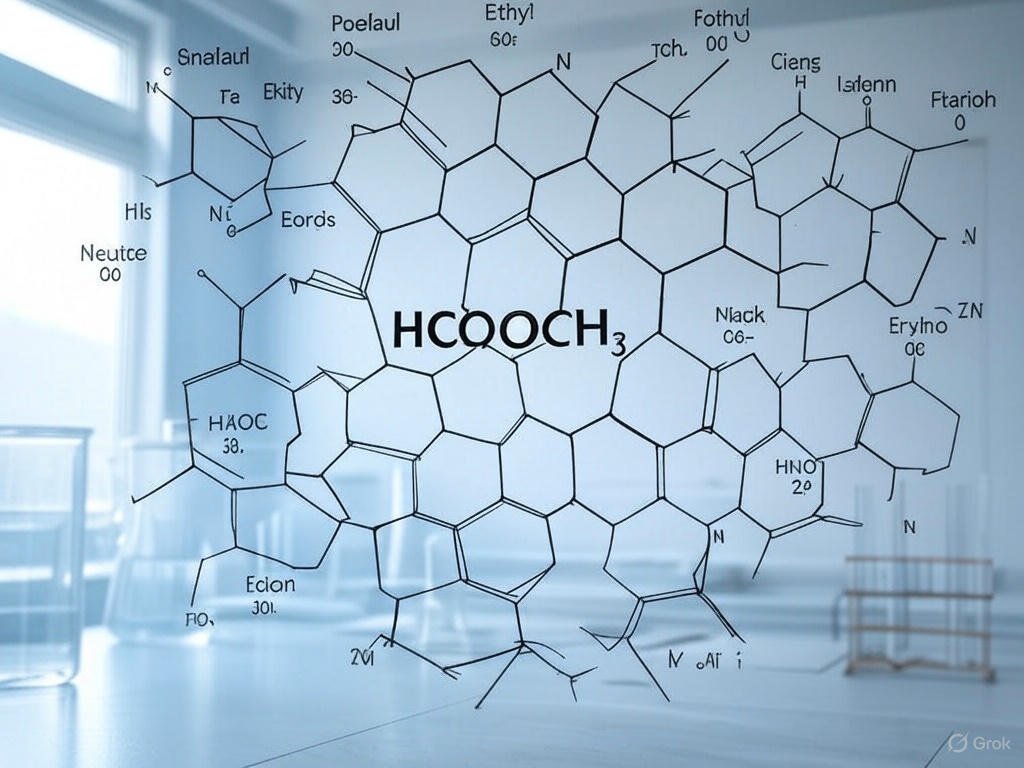Introduction
Imagine you’re in a lab, tasked with identifying a volatile ester in a sample—how do you confirm it’s methyl formate (HCOOCH₃)? This common organic compound, often encountered in chemical synthesis, environmental studies, or reaction analysis, requires precise analytical methods for accurate detection. Searches like “hcooch ch2 h2o analysis” often point to lab-based studies of methyl formate, either as a pure compound or in reaction contexts like hydrolysis. In this guide, we’ll explore the key “methyl formate analytical techniques” used to identify and study this ester, including NMR, IR spectroscopy, and GC-MS. We’ll provide practical tips for chemists, discuss challenges, and look at future trends in organic compound analysis. Whether you’re a lab technician, analytical chemist, or graduate student, this article will equip you with the tools to analyze methyl formate effectively.
Why Analyze Methyl Formate?
The Importance of Methyl Formate Detection
Methyl formate (HCOOCH₃) is a small ester with a low boiling point (~31.5°C), making it a frequent target for analysis in various fields. In chemical synthesis, it’s analyzed to ensure purity during production of solvents, fuels, or intermediates. In environmental monitoring, trace amounts are detected in air or water samples, as methyl formate can be a volatile organic compound (VOC) emitted from industrial processes. Additionally, researchers study its reaction kinetics, such as hydrolysis, where “hcooch ch2 h2o” might reflect searches for its breakdown products in aqueous environments.
The challenges in analyzing methyl formate stem from its volatility and structural similarity to other esters like ethyl formate. This necessitates precise “ester detection methods” to avoid misidentification. Accurate analysis ensures quality control, regulatory compliance, and advances in organic chemistry research, particularly in understanding reaction mechanisms and environmental impacts.
Diagram: Molecular structure of methyl formate (HCOOCH₃), with a central carbon double-bonded to oxygen, single-bonded to a hydrogen, and linked via an oxygen to a methyl group (CH₃). Alt text: “methyl formate molecular structure for analysis.”
Key Analytical Techniques for Methyl Formate
Top Methods for Detection and Study
To identify and quantify methyl formate in the lab, several “methyl formate spectroscopy” techniques stand out for their reliability and specificity. Below, we dive into the three most widely used methods, each offering unique insights into this organic compound.
Nuclear Magnetic Resonance (NMR) Spectroscopy
NMR spectroscopy is a cornerstone for structural analysis of methyl formate. Using ¹H-NMR, chemists can identify the formate proton (~8 ppm) and the methoxy protons of the CH₃ group (~3.7 ppm). In ¹³C-NMR, characteristic peaks appear at ~160 ppm for the carbonyl carbon and ~51 ppm for the methoxy carbon. This method excels at confirming molecular structure, making it ideal for purity checks in synthesized samples.
Advantages: NMR provides high specificity, distinguishing methyl formate from similar compounds.
Limitations: It requires deuterated solvents (e.g., CDCl₃), and its sensitivity is lower for trace analysis, often needing higher sample concentrations.
Visual: Sample ¹H-NMR spectrum of methyl formate, showing peaks at ~8 ppm (formate H) and ~3.7 ppm (methoxy H). Alt text: “methyl formate NMR spectrum.”
Infrared (IR) Spectroscopy
IR spectroscopy is a quick, non-destructive method to detect methyl formate by identifying its functional groups. The ester’s C=O stretch appears at ~1720 cm⁻¹, while the C-O stretch is observed at ~1200 cm⁻¹. These vibrational modes are distinct markers for esters, making IR ideal for qualitative analysis in “organic compound analysis.”
Advantages: IR is fast and requires minimal sample preparation, often using attenuated total reflectance (ATR) for liquid samples.
Limitations: Spectral overlap with other esters can complicate identification, requiring careful interpretation.
Visual: IR spectrum of methyl formate, with labeled peaks at 1720 cm⁻¹ (C=O) and 1200 cm⁻¹ (C-O). Alt text: “methyl formate IR spectrum.”
Gas Chromatography-Mass Spectrometry (GC-MS)
For trace detection and quantification, GC-MS is the gold standard. Gas chromatography separates volatile compounds like methyl formate based on their interaction with a non-polar column (e.g., DB-5). The compound elutes at a specific retention time, and mass spectrometry confirms its identity via the molecular ion (m/z 60) and characteristic fragments (e.g., m/z 31 for CH₃O⁺).
Advantages: GC-MS offers high sensitivity, detecting methyl formate at parts-per-billion levels, making it perfect for environmental or biological samples.
Limitations: It requires calibration with standards and access to specialized equipment, which can be costly.
Visual: GC-MS chromatogram of methyl formate, showing a peak at its retention time with an inset mass spectrum (m/z 60). Alt text: “methyl formate GC-MS chromatogram.”
These techniques collectively provide a robust framework for analyzing methyl formate, addressing both structural and quantitative needs in the lab.
Practical Tips for Accurate Analysis
Best Practices for Lab Analysis
Analyzing methyl formate requires careful attention to detail due to its volatility and potential for interference. Here are some practical tips to ensure accurate results using “ester detection methods.”
Sample Preparation:
- Store samples in sealed vials at low temperatures (e.g., 4°C) to prevent evaporation, given methyl formate’s low boiling point.
- For NMR, dissolve in deuterated chloroform (CDCl₃); for GC-MS, dilute in methanol to avoid column contamination.
Instrument Settings:
- NMR: Optimize for small molecules by setting short relaxation delays (e.g., 1–2 seconds) to capture sharp peaks.
- IR: Use ATR mode for direct analysis of liquid samples, ensuring the crystal is clean to avoid background noise.
- GC-MS: Select a non-polar column like DB-5, and set the oven temperature to ramp from 30°C to 150°C at 10°C/min for optimal separation.
Avoiding Errors:
- Prevent contamination by ensuring glassware is free of other esters, which can mimic methyl formate’s signals.
- Calibrate instruments using pure methyl formate standards to establish baseline retention times or spectral peaks.
Comparison of Analytical Techniques
| Technique | Sensitivity | Cost | Best Use Case |
|---|---|---|---|
| NMR | Moderate | High | Structural confirmation |
| IR | Low | Moderate | Functional group identification |
| GC-MS | High | High | Trace analysis in mixtures |
Future Trends in Methyl Formate Analysis
Innovations in Analytical Chemistry
The field of methyl formate analysis is evolving with new technologies and methodologies. High-resolution mass spectrometry (HRMS) is improving trace detection in complex matrices, allowing chemists to identify methyl formate in environmental samples with greater precision. Portable sensors, such as miniaturized GC-MS devices, are emerging for real-time monitoring in industrial or field settings, reducing the need for lab-based analysis.
Machine learning is also transforming spectral interpretation. Algorithms can now predict NMR or IR peaks, speeding up identification and reducing human error. Future research is focusing on greener solvents for NMR (e.g., ionic liquids) and automated workflows for GC-MS to enhance efficiency.
Emerging Trends:
- Portable GC-MS for on-site environmental analysis.
- AI-driven NMR peak assignment for faster structural elucidation.
- Development of sensors for real-time methyl formate detection in industrial processes.
- Use of microfluidics for miniaturized, high-throughput analysis.
These innovations promise to make “methyl formate analytical techniques” more accessible and efficient. Related Post: Methyl Formate in Space.
New tools may soon help analyze methyl formate in real-time during food processing.
Common Questions About Analyzing Methyl Formate
FAQs on Methyl Formate Analysis
- Which technique is best for detecting methyl formate?
GC-MS is ideal for trace analysis in complex mixtures, while NMR excels at structural confirmation in pure samples. - How does “hcooch ch2 h2o” relate to lab analysis?
It likely refers to studies of methyl formate in reaction contexts, such as hydrolysis, where water (H₂O) is involved. - What challenges arise in methyl formate analysis?
Its volatility requires careful sample handling, and spectral overlap with other esters can lead to misidentification.
Not sure how methyl formate differs from similar esters? Explore this comparison
Conclusion
Analyzing methyl formate in the lab is a critical task for chemists, enabled by powerful techniques like NMR, IR spectroscopy, and GC-MS. These “methyl formate analytical techniques” provide detailed insights into its structure, purity, and presence in complex mixtures, supporting applications from quality control to environmental monitoring. By following best practices—such as proper sample handling and instrument calibration—chemists can achieve accurate, reproducible results. As innovations like portable sensors and AI-driven analysis emerge, the future of methyl formate analysis looks promising. Ready to dive deeper? Check out our guide on astrochemistry or share your lab tips in the comments!

Marian T. Clements is a Ph.D. chemist with 15 years of experience in organic chemistry, specializing in esters like methyl formate. Her work focuses on their applications in food flavoring, perfumery, and chemical analysis, bridging science and industry. Marian has collaborated with top brands to innovate sustainable products and is dedicated to educating others on chemistry’s role in everyday life.





2 thoughts on “Analyzing Methyl Formate: Techniques for Detection and Study”